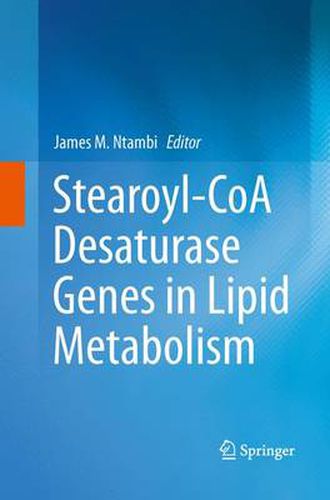Readings Newsletter
Become a Readings Member to make your shopping experience even easier.
Sign in or sign up for free!
You’re not far away from qualifying for FREE standard shipping within Australia
You’ve qualified for FREE standard shipping within Australia
The cart is loading…






This title is printed to order. This book may have been self-published. If so, we cannot guarantee the quality of the content. In the main most books will have gone through the editing process however some may not. We therefore suggest that you be aware of this before ordering this book. If in doubt check either the author or publisher’s details as we are unable to accept any returns unless they are faulty. Please contact us if you have any questions.
Obesity and diabetes develop as a complex result of genetic, metabolic and environmental factors and are characterized by increased lipogenesis and lipid accumulation in many tissues. Stearoyl-CoA desaturase (SCD) genes are a critical regulator of lipogenesis and catalyzes the synthesis of monounsaturated fatty acids (MUFA), mainly oleoyl- (18:1n9) and palmitoleoyl-CoA (16:1n7). These MUFAs are the major fatty acid substrates for the synthesis of triglycerides, cholesterol esters, wax esters and membrane phospholipids. There are 4 SCD isoforms (SCD1-4) in mice and two (hSCD1 and hSCD5) expressed in humans.
At first glance, stearoyl-CoA desaturase enzyme would be considered a housekeeping enzyme because it synthesizes oleate a well-known fatty acid that is abundant in many dietary sources. However numerous studies have shown that SCD is a very highly regulated enzyme that features in so many physiological processes ranging from fat differentiation, carbohydrate and fat metabolism, inflammation and cancer. The editor’s studies using stearoyl-CoA desaturase knockout (SCD1-/-) mice and studies of other investigators using pharmacological approaches to reduce SCD1 expression in mouse tissues have all established that the expression of SCD1 gene isoform represents a key step in partitioning of lipids between storage and oxidation. High SCD expression favors fat storage leading to obesity while reduced SCD expression favors fat burning and leanness. Although these studies clearly illustrated that SCD1 expression is involved in the development of obesity and insulin resistance, questions remain in the elucidation of the mechanisms involved and role of SCD1.
This book includes chapters by leading researchers on SCD Genes in the brain, heart, muscle, liver metabolism, Colitis, and more.
$9.00 standard shipping within Australia
FREE standard shipping within Australia for orders over $100.00
Express & International shipping calculated at checkout
This title is printed to order. This book may have been self-published. If so, we cannot guarantee the quality of the content. In the main most books will have gone through the editing process however some may not. We therefore suggest that you be aware of this before ordering this book. If in doubt check either the author or publisher’s details as we are unable to accept any returns unless they are faulty. Please contact us if you have any questions.
Obesity and diabetes develop as a complex result of genetic, metabolic and environmental factors and are characterized by increased lipogenesis and lipid accumulation in many tissues. Stearoyl-CoA desaturase (SCD) genes are a critical regulator of lipogenesis and catalyzes the synthesis of monounsaturated fatty acids (MUFA), mainly oleoyl- (18:1n9) and palmitoleoyl-CoA (16:1n7). These MUFAs are the major fatty acid substrates for the synthesis of triglycerides, cholesterol esters, wax esters and membrane phospholipids. There are 4 SCD isoforms (SCD1-4) in mice and two (hSCD1 and hSCD5) expressed in humans.
At first glance, stearoyl-CoA desaturase enzyme would be considered a housekeeping enzyme because it synthesizes oleate a well-known fatty acid that is abundant in many dietary sources. However numerous studies have shown that SCD is a very highly regulated enzyme that features in so many physiological processes ranging from fat differentiation, carbohydrate and fat metabolism, inflammation and cancer. The editor’s studies using stearoyl-CoA desaturase knockout (SCD1-/-) mice and studies of other investigators using pharmacological approaches to reduce SCD1 expression in mouse tissues have all established that the expression of SCD1 gene isoform represents a key step in partitioning of lipids between storage and oxidation. High SCD expression favors fat storage leading to obesity while reduced SCD expression favors fat burning and leanness. Although these studies clearly illustrated that SCD1 expression is involved in the development of obesity and insulin resistance, questions remain in the elucidation of the mechanisms involved and role of SCD1.
This book includes chapters by leading researchers on SCD Genes in the brain, heart, muscle, liver metabolism, Colitis, and more.